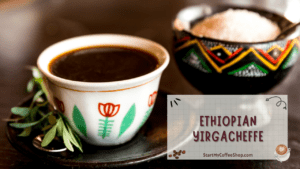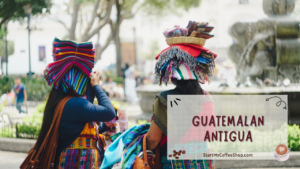The cornerstone of delighting in a refreshing and smooth cup of cold brew coffee is the selection of high-quality coffee beans. Among the several kinds available, some stand out for their unique flavor profiles and compatibility with the cold brewing method.
To achieve optimal results when making cold brew coffee, you should begin with high-quality coffee bean varieties such as Ethiopian Yirgacheffe, Colombian Supremo, Brazilian Santos, and Guatemalan Antigua. These beans possess a smooth, rich flavor profile that pairs perfectly with the cold brewing method.
In this article, we’ll look at the qualities of these coffee bean varietals and why they’re considered the best for making the perfect cold brew. We’ll reveal the secrets to getting the best results from cold brew coffee.
Ethiopian Yirgacheffe: The Fragrant Elixir

Coffee beans from Ethiopian Yirgacheffe have earned a well-deserved reputation for their fragrant attributes and have established themselves as a mainstay in the world of specialty coffee. These beans, which are cultivated at high altitudes in the verdant regions of Ethiopia, feature distinctive qualities that make them an excellent option for the preparation of cold brew coffee.
The flavor profile of Ethiopian Yirgacheffe coffee beans is significantly influenced by the growing circumstances in which the beans are grown. The rich soil of this country, which is located at altitudes ranging from 1,700 to 2,200 meters above sea level, is ideal for the growth of coffee plants. The beans can develop their unique qualities to their full potential because of the high altitude, which, when paired with the region’s favorable climate and copious amounts of rainfall, produces the optimum growing conditions. These conditions help contribute to the gradual and consistent maturity of the coffee cherries, which ultimately results in a flavor that is more nuanced and sophisticated.
The high quality of Ethiopian Yirgacheffe beans is also attributable, in part, to the processing processes that are used on these beans. The washed or wet process is the name given to the approach that has been employed traditionally in the area. After the ripe coffee cherries have been collected, they are pulped in such a way as to remove the outer fruit layer, thereby exposing the coffee seeds or beans underneath. After this step, the beans are fermented in water for a predetermined amount of time to eliminate any remaining mucilage, and then they are washed and dried thoroughly. This rigorous method helps to maintain the natural taste of the beans, which results in a cup of coffee that is fresh and full of vitality.
When used to make cold brew coffee, Ethiopian Yirgacheffe beans exhibit their distinctive flavor profile in a way that is undeniably one of the most alluring qualities of these beans. The beans have a mild acidity, which brings vivacity and brightness to the flavor of the cold brew as a whole. It is common practice to characterize the flavor notes of Ethiopian Yirgacheffe as floral and fruity, with undertones of jasmine, bergamot, lemon, and blueberry. Every sip of cold brew coffee is enhanced with a touch of sophistication and depth thanks to these delectable flavor characteristics, which also contribute to the beverage’s intoxicating scent.
Ethiopian Yirgacheffe beans have a scent that can only be described as magnificent. A fascinating aroma permeates the room as soon as the freshly ground beans are steeped in the cold water. The floral and zesty aromas come through very strongly, which makes the act of brewing a pleasingly aromatic adventure for the senses. The alluring scent of Ethiopian Yirgacheffe contributes an additional dimension of pleasure to the whole experience of drinking cold brew coffee, which already provides a high level of satisfaction on its own.
Read more about: How Much Will it Cost to Start a Coffee Shop: A Cup of Coffee and a Dollar Sign
Colombian Supremo: The Smooth Operator
Colombian Supremo coffee beans are a well-liked option among coffee connoisseurs all around the world. These beans are renowned for having a complex and well-balanced flavor profile, making them a superb starting point for creating outstanding cold-brew coffee.
Its varied and beautiful locations, where coffee cultivation flourishes because of the nation’s ideal geology and climate, are where Colombian Supremo beans are grown. The Andes Mountains are home to many coffee-growing regions, including Antioquia, Huila, Nario, and Tolima. The flavor profile of Colombian Supremo beans is influenced by the distinct qualities of each location.
Colombian Supremo beans are produced using precise and renowned cultivation and harvesting procedures. Colombian coffee producers use time-honored practices that have been handed down through the years, emphasizing quality and care for the little things. To guarantee that only the ripest cherries are chosen, the beans are often hand-picked, which leads to the best flavor development.
The coffee cherries go through a thorough processing procedure after being collected. The outer fruit layer of the cherries is delicately pulled away to expose the coffee beans. The beans are then properly rinsed and dried before being fermented to remove any pulp that may still be present. The essential properties of the beans are preserved by this careful processing method, which also allows the flavors to stand out in the finished cup.
When used for cold brew, the velvety smoothness of Colombian Supremo beans is one of their distinguishing qualities. The beans have a rich, pleasant texture and a medium body. This quality lends itself wonderfully to the cold brewing technique since it enables the tastes to mature fully and meld together tastefully. The desired characteristics of Colombian Supremo beans are extracted throughout the cold brewing process, producing a smooth and flavorful cup of cold brew.
Colombian Supremo beans provide a pleasant sweetness that improves the taste of cold brew. Caramel, chocolate, and hints of fruity flavor are frequently present in the flavor notes. These ingredients combine to produce a flavor profile that is both luxurious and well-balanced. The natural sweetness of Colombian Supremo beans gives cold brew coffee a natural sweetness; no added sugar or sweeteners are required.
The adaptability of Colombian Supremo beans enables experimentation when preparing cold brew with various brewing techniques and ratios. Colombian Supremo beans can adjust to different preferences, giving consistent quality and flavor, whether you like a stronger, more concentrated brew or a softer, smoother cup.
Brazilian Santos: The Bold & Nutty Delight
Brazilian Santos coffee beans, which come from the world’s greatest producer of coffee, have a distinctive and strong personality that harmonizes beautifully with the cold brewing process. Explore the elements that make Brazilian Santos distinctive, such as the wide Brazilian landscapes and the conventional drying techniques used during processing, to fully enjoy the flavor profile. Brazilian Santos beans provide depth and complexity to cold brew coffee, ensuring a memorable and robust cup with their nutty undertones and full-bodied richness.
Brazil’s wide and varied landscapes offer the perfect conditions for growing coffee. Brazilian coffee fields profit from a variety of altitudes and microclimates, from the rolling hills of Minas Gerais to the high plateaus of So Paulo and the rich regions of Espirito Santo. These geographical variations, together with a lot of sunshine and regular rain, help the coffee beans acquire their flavors.
The natural process, also known as dry processing, is a vital component of Brazilian Santos coffee beans. The cherries are carefully arranged in the sun on patios or raised beds after being harvested. The cherries give the beans different flavors as they naturally dry. By absorbing some of the fruit’s sweetness and natural sugars during this natural drying process, the beans’ flavor profile is improved.
Brazilian Santos beans exhibit a variety of pleasant qualities when used for cold brew coffee. The beans’ nutty overtones and aromas, which are reminiscent of almonds and hazelnut, give the cold brew a delicious richness. The strong and pleasant cup that results from cold brewing Brazilian Santos is a result of its full-bodied character.
These beans feature a balanced and low-acidity profile in addition to their nutty and full-bodied characteristics. Because of this quality, they are a fantastic option for people who like a smoother and less acidic cold brew experience. The lower acidity makes it possible for additional flavor notes, such as caramel or chocolate, to stand out, making for a pleasant and well-rounded drinking experience.
Brazilian Santos beans also offer flexibility for experimenting in the field of cold brew. Brazilian Santos adapts well to various brewing techniques and ratios, whether choosing a longer steeping time for a stronger concentrate or a shorter steeping time for a milder brew. This versatility guarantees that coffee lovers can personalize their cold brew experience to fit their tastes.
Guatemalan Antigua: The Complex Connoisseur

The nuanced and alluring taste notes of Guatemalan Antigua coffee beans have won them their praise, and they are a superb choice for creating beautiful cold brew coffee. These beans are grown in the gorgeous Antigua region, which is noted for its volcanic soils, and have a delicious blend of acidity, sweetness, and slight smokiness. We can better comprehend the layers of tastes that emerge in each sip of cold brew produced from Guatemalan Antigua beans by digging into the rigorous agricultural procedures, hand-picking processes, and distinctive volcanic terroir.
Because of the area’s stunning scenery and fertile volcanic soils, Guatemalan Antigua coffee beans are grown there. The region, which is surrounded by the three volcanoes Agua, Fuego, and Acatenango, benefits from centuries’ worth of nutrient-rich volcanic ash deposition. The coffee trees receive special traits from the volcanic terroir, which affects the flavor profile of the beans they produce.
Antigua beans from Guatemala are painstakingly grown using conventional methods. Coffee farmers in the area use meticulous farming practices that take into account elements like soil composition, altitude, and shadow. The beans’ desired acidity and brightness are a result of their high altitude, which is between 1,200 and 1,800 meters above sea level. The natural trees’ shade and the mineral-rich volcanic soil add to the beans’ distinctive flavors.
The hand-picking technique used to harvest Guatemalan Antigua beans is one of their distinctive qualities. Each bean is of the best quality since skilled employees only select the ripest cherries. The depth and consistency of the beans’ flavor are a result of the thorough selecting procedure.
When used to make cold brew coffee, the flavor characteristic of Guatemalan Antigua beans shines. The beans’ acidity, sweetness, and light smokiness are perfectly balanced. Bright and vibrant acidity gives the cold brew a wonderful liveliness. The sweetness is frequently accompanied by undertones of caramel and chocolate, giving the flavor a pleasant richness. The beans have a light smokiness, which gives the cold brew depth and complexity and a multifaceted flavor.
A symphony of tastes emerges when one takes a drink of cold brew prepared from Guatemalan Antigua beans. The sweetness and light smokiness that follow the acidity dance on the palate in unison. The complex interplay of flavors reveals the skillful cultivation of the beans as well as their distinctive qualities.
When creating cold brew, the adaptability of Guatemalan Antigua beans enables experimenting with brewing methods and ratios. Guatemalan Antigua beans adapt well to various techniques, providing consistency and perfection in each brew, whether one chooses a longer steeping time for a richer flavor or a shorter steeping time for a more delicate cup.
Read more about: How Much Would it Cost to Open a Coffee Shop: Calculating the Cost
Frequently Asked Questions

Why are premium coffee beans varietals like Guatemalan Antigua, Brazilian Santos, Colombian Supremo, and Ethiopian Yirgacheffe preferred for cold brew coffee?
To make cold brew coffee, coffee grounds are steeped in cold water for a prolonged length of time, usually between 12 and 24 hours. Starting with high-quality coffee bean varietals is vital for a tasty and smooth cold brew. Yirgacheffe from Ethiopia, Supremo from Colombia, Santos from Brazil, and Antigua from Guatemala are renowned for their excellent flavor profiles that go well with cold brewing. These beans are exceptional alternatives for crafting a pleasurable cold brew experience since they have distinctive qualities including floral and fruity notes (Ethiopian Yirgacheffe), smoothness and balance (Colombian Supremo), robustness and nuttiness (Brazilian Santos), and complexity (Guatemalan Antigua).
Are these the only acceptable types of coffee bean variations for cold brew coffee, or can I use other coffee bean varieties?
Even while Colombian Supremo, Brazilian Santos, Guatemalan Antigua, and Ethiopian Yirgacheffe are all highly suggested for cold brew coffee, they are not the only viable choices. Numerous additional types of coffee beans can likewise yield fantastic outcomes in cold brew. It’s crucial to select beans with qualities that work well with cold brewing, like low acidity, smoothness, and a flavor profile that can withstand a lengthy steeping period. Exciting flavor discoveries in your cold brew can be made by experimenting with various coffee bean varietals from varied origins, like Kenyan, Costa Rican, or Sumatran. Finding flavors and profiles that suit your unique preferences is what matters most in the end.
Are there any particular guidelines or advice for buying these premium coffee bean varieties?
There are a few things to bear in mind when looking for premium coffee bean kinds including Guatemalan Antigua, Brazilian Santos, Colombian Supremo, and Ethiopian Yirgacheffe. Freshness is important, to start. To ensure the best flavor, look for newly roasted beans. Freshly roasted beans are frequently available from reliable online vendors and specialty coffee establishments. Second, think about the roasting intensity. Cold brew often benefits most from light to medium roasts because they preserve more of the natural tastes of the beans. Think about buying whole beans and grinding them yourself right before brewing. This keeps the coffee fresher longer and enables you to change the grind size to suit your chosen brewing technique. By considering these elements, you can improve your cold brew experience by using the best coffee bean kinds on the market.
To learn more on how to start your own coffee shop, check out my startup documents here.
Disclaimer: The information provided by StartMyCoffeeShop.com (“The Site”) is for general informational purposes only. All information on the Site is provided in good faith. However, we make no representation or warranty of any kind, express or implied, regarding the accuracy, adequacy, validity, reliability, availability, or completeness of any information on the Site. Under no circumstance shall we have any liability to you for any loss or damage of any kind incurred as a result of the use of the Site or Reliance on any information provided on the Site. Your use of the Site and reliance on any information on the Site is solely at your own risk. This blog post is for educational purposes only and does not constitute legal advice. Please consult a legal expert to address your specific needs. Terms and Conditions. (https://startmycoffeeshop.com/terms-and-conditions/)

Hi! I’m Shawn Chun
My adventure in coffee began when I first launched my first coffee shop back in the early 2000s. I had to figure out so many things on my own and to make it worse within 2 years of opening two large corporate coffee chains moved in just blocks away from me!
As I saw smaller and even some larger coffee shops in the neighborhood slowly lose customers to these giant coffee chains and slowly close up shop, I knew that I had to start getting creative…or go out of business.
I (like you may be) knew the coffee industry well. I could make the best latte art around and the foam on my caps was the fluffiest you have ever seen. I even had the best state-of-the-art 2 group digital Nuova Simonelli machine money could buy. But I knew that these things alone would not be enough to lure customers away from the name brand established coffee shops.
Eventually, through lots of trial and error as well as perseverance and creativity I did find a way to not only survive but also thrive in the coffee/espresso industry even while those corporate coffee chains stayed put. During those years I learned to adapt and always faced new challenges. It was not always easy, however, in the end, I was the sole survivor independent coffee shop within a 10-mile radius of my location. Just two corporate coffee chains and I were left after that year. All told the corporate coffee chains took down over 15 small independent coffee shops and kiosks and I was the last one standing and thriving.
Along the years I meet others with the same passion for coffee and I quickly learned that it is not only “how good a barista is” that makes a coffee shop successful, but the business side of coffee as well.
Hence why I started this website you are on now. To provide the tools and resources for up and coming coffee shop owners to gain that vital insight and knowledge on how to start a coffee shop successfully.
Stick around, browse through my helpful blog and resources and enjoy your stay! With lots of LATTE LOVE!
Shawn







